宏观经济学第十八章 习题答案
第十六,十八,二十一章_宏观经济综合练习--参考答案版
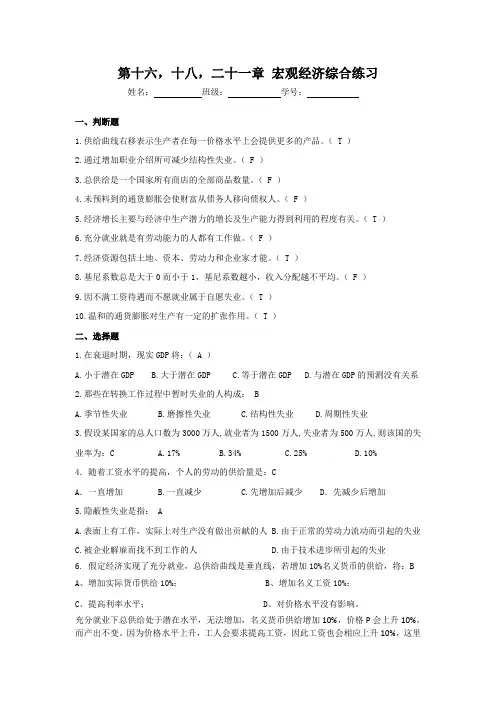
第十六,十八,二十一章宏观经济综合练习姓名:班级:学号:一、判断题1.供给曲线右移表示生产者在每一价格水平上会提供更多的产品。
( T)2.通过增加职业介绍所可减少结构性失业。
( F)3.总供给是一个国家所有商店的全部商品数量。
( F)4.未预料到的通货膨胀会使财富从债务人移向债权人。
( F)5.经济增长主要与经济中生产潜力的增长及生产能力得到利用的程度有关。
( T)6.充分就业就是有劳动能力的人都有工作做。
( F)7.经济资源包括土地、资本、劳动力和企业家才能。
( T)8.基尼系数总是大于0而小于1,基尼系数越小,收入分配越不平均。
( F)9.因不满工资待遇而不愿就业属于自愿失业。
( T)10.温和的通货膨胀对生产有一定的扩张作用。
( T)二、选择题1.在衰退时期,现实GDP将:( A )A.小于潜在GDPB.大于潜在GDPC.等于潜在GDPD.与潜在GDP的预测没有关系2.那些在转换工作过程中暂时失业的人构成: BA.季节性失业B.磨擦性失业C.结构性失业D.周期性失业3.假设某国家的总人口数为3000万人,就业者为1500万人,失业者为500万人,则该国的失业率为:C A.17% B.34% C.25% D.10%4.随着工资水平的提高,个人的劳动的供给量是:CA.一直增加 B.一直减少 C.先增加后减少 D.先减少后增加5.隐蔽性失业是指: AA.表面上有工作,实际上对生产没有做出贡献的人B.由于正常的劳动力流动而引起的失业C.被企业解雇而找不到工作的人D.由于技术进步所引起的失业6. 假定经济实现了充分就业,总供给曲线是垂直线,若增加10%名义货币的供给,将:BA、增加实际货币供给10%;B、增加名义工资10%;C、提高利率水平;D、对价格水平没有影响。
充分就业下总供给处于潜在水平,无法增加,名义货币供给增加10%,价格P会上升10%,而产出不变。
因为价格水平上升,工人会要求提高工资,因此工资也会相应上升10%,这里只是名义工资上升10%,实际工资w=W/P保持不变:因为分子和分母都提高10%,所以实际工资w保持不变。
人大宏观经济学课件ch18习题答案
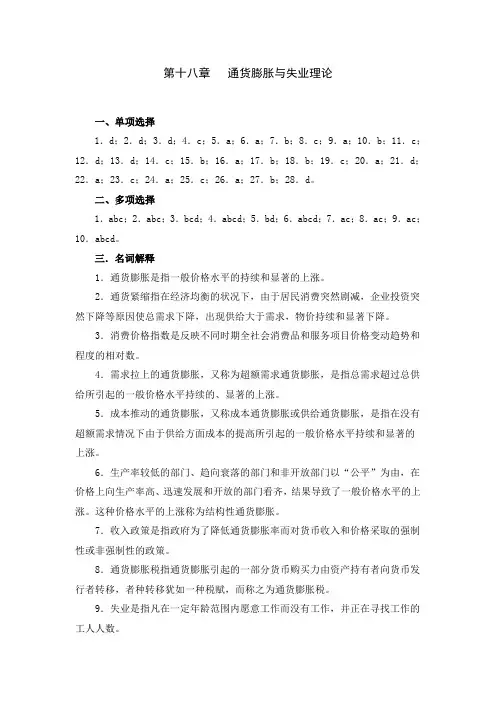
第十八章通货膨胀与失业理论一、单项选择1.d;2.d;3.d;4.c;5.a;6.a;7.b;8.c;9.a;10.b;11.c;12.d;13.d;14.c;15.b;16.a;17.b;18.b;19.c;20.a;21.d;22.a;23.c;24.a;25.c;26.a;27.b;28.d。
二、多项选择1.abc;2.abc;3.bcd;4.abcd;5.bd;6.abcd;7.ac;8.ac;9.ac;10.abcd。
三.名词解释1.通货膨胀是指一般价格水平的持续和显著的上涨。
2.通货紧缩指在经济均衡的状况下,由于居民消费突然剧减,企业投资突然下降等原因使总需求下降,出现供给大于需求,物价持续和显著下降。
3.消费价格指数是反映不同时期全社会消费品和服务项目价格变动趋势和程度的相对数。
4.需求拉上的通货膨胀,又称为超额需求通货膨胀,是指总需求超过总供给所引起的一般价格水平持续的、显著的上涨。
5.成本推动的通货膨胀,又称成本通货膨胀或供给通货膨胀,是指在没有超额需求情况下由于供给方面成本的提高所引起的一般价格水平持续和显著的上涨。
6.生产率较低的部门、趋向衰落的部门和非开放部门以“公平”为由,在价格上向生产率高、迅速发展和开放的部门看齐,结果导致了一般价格水平的上涨。
这种价格水平的上涨称为结构性通货膨胀。
7.收入政策是指政府为了降低通货膨胀率而对货币收入和价格采取的强制性或非强制性的政策。
8.通货膨胀税指通货膨胀引起的一部分货币购买力由资产持有者向货币发行者转移,者种转移犹如一种税赋,而称之为通货膨胀税。
9.失业是指凡在一定年龄范围内愿意工作而没有工作,并正在寻找工作的工人人数。
10.失业率是指失业人数在劳动力总数中所占的百分比。
11.充分就业是指周期性失业人数为零的就业状态。
充分就业并非人人都有工作。
12.自然失业率是指经济社会在正常情况下的失业率,它是劳动市场处于供求稳定状态时的失业率。
宏观经济学-第十八章失业与通货膨胀
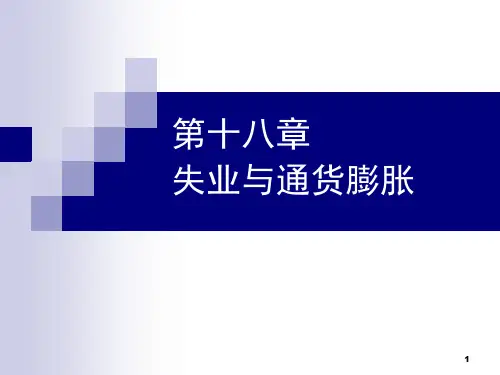
货币数量论的解释,强调货币在通货膨胀过程中的 重要性;
利用总需求与总供给解释,包括从需求的角度和供 给的角度的解释;
从经济结构因素变动的角度来说明。
19
一、作为货币现象的通货膨胀 源于货币数量论。
基本思想:过多的钞票追逐过少的商品。每一次 通货膨胀背后都有货币供给的迅速增长。 出发点: MV=Py
注意:
是一般物价水平上涨。 是在较长时间内持续上涨,是一种非稳定状态。 是以较高的幅度上涨。
13
二、通货膨胀的衡量
1.价格指数 用以描述整个经济中的各种商品和劳务价格的总体
平均数。 GDP折算指数
GDP折算指数=名义GDP/实际GDP 消费者价格指数(CPI)
一组相对固定的商品和劳务当期价格与基期价格的 比值。 生产者价格指数(PPI)
致新的产品和产业变化、新技术的进步导 致产业的变化等。
4
3.周期性失业: 又称需求不足的失业、非自愿失业。 由于总需求不足而引起的失业,一般 出现在经济周期的萧条阶段。
5
4.其他的失业类型: 季节性失业 技术性失业 隐性失业
6
三、自然失业率和自然就业率
1.自然失业率
定义:指当劳动市场处于供求稳定状态时的失业率。 实现了充分就业时的失业率就是自然失业率。
17
3.按照人们的预期程度加以区分
➢ 未预期到的通货膨胀,价格上升速度超出人 们的预料,或者人们根本没有想到价格会上 涨。
➢ 预期到的通货膨胀,也称为惯性的通货膨胀, 指物价有规律的变动。
18
第五节 通货膨胀的原因
宏观经济主体及其行为、微观经济主体及其行为, 都会从货币供给数量、总需求、总供给、经济结构等方 面促成通货膨胀。
09宏观经济学第十八章
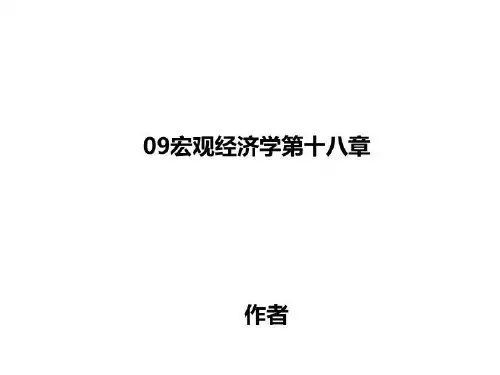
(3)周期性失业
➢ 周期性失业是指经济周期中的衰退或萧条时, 因社会总需求下降而造成的失业。当经济发 展处于一个周期中的衰退期时,社会总需求 不足,因而厂商的生产规模也缩小,从而导 致较为普遍的失业现象。
➢ 通常用紧缩性缺口来说明这种失业产生的原 因。紧缩性缺口是指实际总需求小于充分就 业的总需求时,实际总需求与充分就业总需 求之间的差额。
分就业总需求ADf之间的差额就
是造成这种失业的根源。这种失
业是由于总需求不足引起的,故
而也称为“需求不足的失业”。
15
问:摩擦性失业与结构性失业相比,哪一种失 业问题更严重些?
解答:一般来说,结构性失业比摩擦性失业更 严重。因为摩擦性失业是由于劳动力市场运行 机制不完善或者因为经济变动过程中的工作转 换而产生的失业。摩擦性失业的失业者都可以 胜任可能获得的工作,增强失业服务机构的作 用,增加就业信息,协助劳动者搬家等都有助 于减少摩擦性失业。而结构性失业是由于经济 结构变化,产业兴衰转移而造成的失业,是劳 动力失衡造成的失业,一些部门需要劳动力。 存在职位空缺,但失业者缺乏到这些部门和岗 位就业的能力,而这种能力的培训需要一段较 长的时间才能完成,所以结构性失业的问题更 严重一些。
12
(2)结构性失业
➢ 第一是技术变化,原有劳动者不能适应新技 术的要求,或者是技术进步使得劳动力需求 下降;
➢ 第二是消费者偏好的变化。消费者对产品和 劳务的偏好的改变,使得某些行业扩大而另 一些行业缩小,处于规模缩小行业的劳动力 因此而失去工作岗位;
➢ 第三是劳动力的不流动性。流动成本的存在 制约着失业者从一个地方或一个行业流动到 另一个地方或另一个行业,从而使得结构性 失业长期存在。
➢ 另一种是非自愿失业,是指有劳动能力、愿 意接受现行工资水平但仍然找不到工作的现 象。这种失业是由于客观原因所造成的,因 而可以通过经济手段和政策来消除。经济学 中所讲的失业是指非自愿失业。
宏观经济学 曼昆 习题答案 章节18
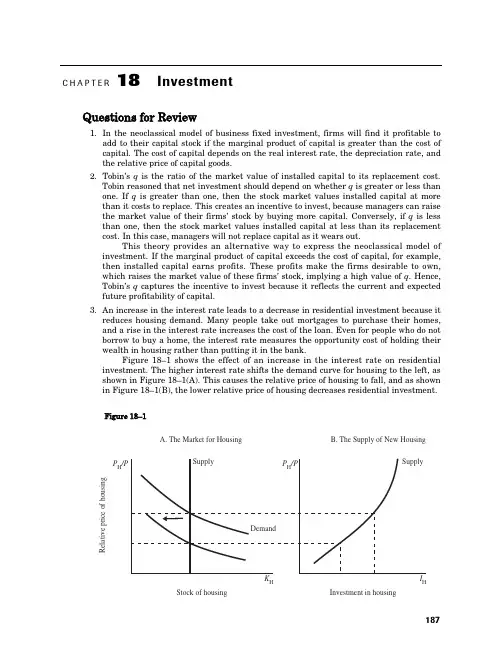
4.Reasons why firms might hold inventories include:a.Production smoothing . A firm may hold inventories to smooth the level of produc-tion over time. Rather than adjust production to match fluctuations in sales, it may be cheaper to produce goods at a constant rate. Hence, the firm increases inventories when sales are low and decreases them when sales are high.b.Inventories as a factor of production . Holding inventories may allow a firm tooperate more efficiently. For example, a retail store may hold inventories so that it always has goods available to show customers. A manufacturing firm may hold inventories of spare parts to reduce the time an assembly line is shut down when a machine breaks.c.Stock-out avoidance . A firm may hold inventories to avoid running out of goodswhen sales are unexpectedly high. Firms often have to make production decisions before knowing how much customers will demand. If demand exceeds production and there are no inventories, the good will be out of stock for a period, and the firm will lose sales and profit.d.Work in process . Many goods require a number of steps in production and, there-fore, take time to produce. When a product is not completely finished, its compo-nents are counted as part of a firm’s inventory.Problems and Applications1.In answering parts (a) to (c), it is useful to recall the neoclassical investment function:I = I n [MPK – (P K /P )(r + δ)] + δK .This equation tells us that business fixed investment depends on the marginal product of capital (MPK ), the cost of capital (P K /P )(r + δ), and the amount of depreciation of the capital stock (δK ). Recall also that in equilibrium, the real rental price of capital equals the marginal product of capital.a.The rise in the real interest rate increases the cost of capital(P K /P )(r + δ). Invest-ment declines because firms no longer find it as profitable to add to their capital stock. Nothing happens immediately to the real rental price of capital, because the marginal product of capital does not change.b.If an earthquake destroys part of the capital stock, then the marginal product ofcapital rises because of diminishing marginal product. Hence, the real rental price of capital increases. Because the MPK rises relative to the cost of capital (which does not change), firms find it profitable to increase investment.c.If an immigration of foreign workers increases the size of the labor force, then themarginal product of capital and, hence, the real rental price of capital increase.Because the MPK rises relative to the cost of capital (which does not change),firms find it profitable to increase investment.2.Recall the equation for business fixed investment:I = I n [MPK – (P K /P )(r + δ)] + δK .This equation tells us that business fixed investment depends on the marginal product of capital, the cost of capital, and the amount of depreciation of the capital stock.A one-time tax levied on oil reserves does not affect the MPK : the oil companies must pay the tax no matter how much capital they have. Because neither the benefit of owning capital (the MPK ) nor the cost of capital are changed by the tax, investment does not change either.If the firm faces financing constraints, however, then the amount it invests depends on the amount it currently earns. Because the tax reduces current earnings, it also reduces investment.3. a.There are several reasons why investment might depend on national income.First, from the neoclassical model of business fixed investment we know that anincrease in employment increases the marginal product of capital. Hence, if national income is high because employment increases, then the MPK is high, and firms have an incentive to invest. Second, if firms face financing constraints, then an increase in current profits increases the amount that firms are able to invest.Third, increases in income raise housing demand, which increases the price of housing and, therefore, the level of residential investment. Fourth, the accelerator model of inventories implies that when output rises, firms wish to hold more inventories; this may be because inventories are a factor of production or because firms wish to avoid stock-outs.b.In the Keynesian cross model of Chapter 10, we assumed that I = I . We found thegovernment-purchases multiplier by considering an increase in government expenditure of ΔG . The immediate effect is an increase in income of ΔG . This increase in income causes consumption to rise by MPC ×ΔG . This increase in con-sumption increases expenditure and income once again. This process continues indefinitely, so the ultimate effect on income isΔY = ΔG [1 + mpc + mpc 2+ mpc 3+ . . . ]= (1/(1 – MPC ))ΔG .Hence, the government spending multiplier we found in Chapter 10 isΔY /ΔG = 1/(1 – MPC ).Now suppose that investment also depends on income, so that I = I + aY . Asbefore, an increase in government expenditure by ΔG initially increases income by ΔG . This initial increase in income causes consumption to rise by MPC ×ΔG ; now,it also causes investment to increase by a ×ΔG . This increase in consumption and investment increases expenditure and income once again. The process continues untilΔY = ΔG [1 + (mpc + a ) + (mpc + a )2+ (mpc + a )3+ . . . ]= (1/(1 – MPC – a ))ΔG .Hence, the government-purchases multiplier becomesΔY /ΔG = 1/(1 – MPC – a ).Proceeding the same way, we find that the tax multiplier becomesΔY /ΔT = – MPC /(1 – MPC – a ).Note that the fiscal-policy multipliers are larger when investment dependson income.。
西方经济学宏观部分习题及答案
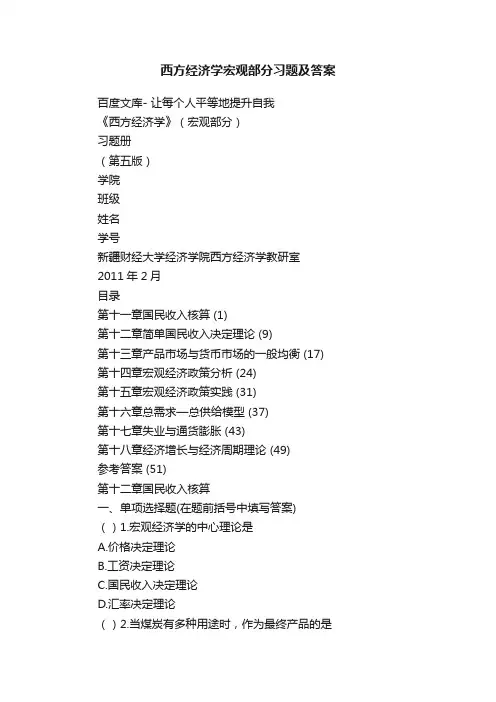
西方经济学宏观部分习题及答案百度文库- 让每个人平等地提升自我《西方经济学》(宏观部分)习题册(第五版)学院班级姓名学号新疆财经大学经济学院西方经济学教研室2011年2月目录第十一章国民收入核算 (1)第十二章简单国民收入决定理论 (9)第十三章产品市场与货币市场的一般均衡 (17) 第十四章宏观经济政策分析 (24)第十五章宏观经济政策实践 (31)第十六章总需求—总供给模型 (37)第十七章失业与通货膨胀 (43)第十八章经济增长与经济周期理论 (49)参考答案 (51)第十二章国民收入核算一、单项选择题(在题前括号中填写答案)()1.宏观经济学的中心理论是A.价格决定理论B.工资决定理论C.国民收入决定理论D.汇率决定理论()2.当煤炭有多种用途时,作为最终产品的是A、家庭用于做饭和取暖B、餐厅用于做饭C、供热公司用于供应暖气D、化工厂作为原料()3.“面粉是中间产品”这一命题A、一定是对的B、一定是不对的C、可能是对的,也可能是不对的D、以上全对()4.下列那一项计入GDP?A、购买一辆用过的旧自行车B、购买普通股票C、汽车制造厂买进十吨钢板D、银行向某企业收取一笔贷款利息()5.在由家庭,企业,政府、国外构成的四部门经济中,GDP=ΣA、消费、净投资、政府购买和净出口B、消费、总投资、政府购买和净出口C、消费、总投资、政府购买和总出口D、工资、地租、利息、利润和折旧()6.下列哪一项不列入国内生产总值的核算?A、出口到国外的一批货物B、政府给贫困家庭发放的一笔救济金C、经纪人为一座旧房买卖收取的一笔佣金D、保险公司收到一笔家庭财产保险费()7.下列项目中,不属于政府购买的是A、地方政府办学校的支出B、政府购买一批军火C、政府给低收入者提供的一笔住房补贴D、政府给公务人员增加工资()8.根据宏观经济学的理论,一笔资金的使用,下列哪一项可以被视为投资:A. 购买公司股票B.存入国外银行C. 购买企业债券D. 以上都不对()9.经济学上的投资是指A、企业增加一笔存货B、建造一座住宅C、企业购买一台计算机D、以上都是()10.中国的资本品存量2008年年初约为80万亿元,本年度资本形成总额可达12万亿元,资本消耗是8万亿元,则中国2008年度的总投资和净投资分别是A、20万亿元和8亿元B、20万亿元和4万亿元C、12万亿元和4万亿元D、12万亿元和8万亿元()11.如果本国居民的国外净要素收入大于零,则有A. GNP=GDPB. GNP=NIC. GNP>GDPD. GDP>GNP()12.在统计中,社会保险税的增加对项有影响A、GDPB、NDPC、NID、PI()13.下列各命题中,正确的是A、NDP+企业间接税=GDPB、NDP-资本折旧=GDPC、国民收入NI=个人收入PID、个人可支配收入DPI=个人收入PI-个人所得税()14.如果个人收入等于570美元,而个人所得税等于90美元,消费等于430美元,利息支付总额为10美元,个人储蓄为40美元,个人可支配收入则等于A、500 美元B、480美元C、470 美元D、400美元()15.已知:消费额为6亿元,投资额为1亿元,资本折旧为1亿元,间接税为1亿元,政府用于商品和劳务的支出为亿元,出口为2亿元,进口为亿元,则A、GDP=亿元B、GDP=亿元C、NDP=亿元D、NDP=亿元()16.国内生产总值与国内生产净值之间的差别是A、直接税B、折旧C、间接税D、净出口()17. 属于转移支付的是A、退伍军人的津贴B、退休人员的退休金C、贫困家庭补贴D、以上答案都对()18. 下列第项不属于要素收入但被居民收到了A、租金B、银行存款利息C、红利D、养老金()19.忽略本国居民对外国人的转移支付,下列投资—储蓄恒等式中不正确的是:A. 两部门经济:I=SB. 三部门经济:I=S+(T-G)C. 四部门经济:I=S+(T-G)+(X-M)D. 四部门经济:I=S+(T-G)+(M-X)()20.今年的名义GDP比去年的名义GDP高,说明A. 今年的物价水平比去年高B. 今年生产的产品和劳务比去年多C. 今年的物价水平和产出水平都比去年高D. 以上说法都有可能二、判断题(在题前括号中填写答案,正确写T,错误写F)()1. 宏观经济学研究社会总体经济行为,运用个量分析方法.()2. 某种物品是中间产品还是最终产品取决于它本身的性质,例如,汽车一定是最终产品,煤只能是中间产品。
巴罗宏观经济学答案Chapter 18
Chapter 18: Exchange RatesAnswers to review questions, pg. 4651. The nominal exchange rate is the rate at which one currency can be traded for another in the foreign exchange market. The real exchange rate adjusts the nominal values for differences in the price level of the two nations. For example, if the price level is 1 in the domestic economy and 4 in the foreign economy, then a nominal exchange rate of 4:1 would generate a real exchange rate of (4/4)/(1/1) = 1. In this example the domestic currency can purchase 4 units of the foreign currency, but only 1 units of the foreign GDP.A fixed exchange rate is based on nominal values.2. The condition is based on the theory that arbitrage (buying goods in markets where the price is low and selling them in markets where the price is high) will tend to eliminate differences in the price of goods in different markets. The equations are based on the assumption that all goods are tradable goods and the transportation costs are relatively insignificant. Another condition is that each country produces some of each good- if one country’s exports a good for which there is no suitable substitute, then the terms of trade may favor that country and PPP will not hold.3. Interest rate parity is based on the concept of arbitrage in asset markets. Assuming that the real exchange rate is one (PPP holds), then the differences in nominal interest rates between countries must be attributable differences in inflation rates. The rationale is that arbitrage will cause real interest rates available in each country to converge.4. In a fixed exchange rate system, monetary policy must produce an inflation rate compatible with the targeted exchange rate. Increases in the supply of money will create inflation which would put downward pressure on the nominal exchange rate. For example consider a country with a targeted nominal exchange rate of 2. If the real exchange rate is equal to one, then the foreign price level must be twice the domestic price level: P f= P implies P f/P=2. Inflation in the domestic economy must be equal to inflationbank may attempt to block the tendency of real exchange rates to converge to one by intervening in the foreign exchange market, using foreign exchange reserves to create a kind of artificial demand for their currency. However, this would reduce the foreign exchange reserves of the central bank. Trade barriers and foreign exchange controls are policy options which could be used to limit the demand for foreign exchange and reduce the need for central bank intervention.5. The real exchange rate in the long run will tend to be equal to one, therefore, differences in the ratio of the price level in the two countries must be accommodated by movements in the nominal exchange rate. The main advantage of the flexible exchange rate system is that it permits Brazil to pursue its monetary policy unconstrained by nominal exchange rate targets. If Brazil pursued inflationary policies in a fixed exchange rate system, then the revaluation that would occur would have destabilizing effects on the economy, as it did for Argentina in 2001.Answers to Problems for discussion, pg. 465-4667. a. In order to maintain its exchange rate target, the central bank could increase the nominal money supply to accommodate the increased demand for money. The growth in the nominal money supply would maintain prices and exchange rates.b. If no action is taken by the Chinese central bank, an increase in money demand would reduce the price level in China and cause the currency to appreciate.8. Answers may vary, but in general, expect the data to confirm that the higher the inflation rate differential, the higher the growth rate in the nominal exchange rate.9. a. The U.S. was facing a balance of payments deficit because the nominal rate overvalued the U.S. dollar. The foreign exchange and gold reserves of the U.S. were decreasing and the nation’s leaders wer e unwilling to sacrifice domestic economic policies for the sake of maintaining the value of the dollar in foreign exchange markets.b. Doubling the price of gold was one option; that would be a severe devaluation of the dollar and might have caused the same kinds of problems for the U.S. economy that East Asia experienced in 1997 and Argentina experienced in 2001. Other options included trade restrictions, a more restrictive monetary policy to reduce inflation and raise nominal interest rates. Under the classical theory of the gold standard, the reduction in gold reserves should have reduced the nominal money supply in the U.S., causing reductions in nominal prices which might have boosted exports and stopped the outflow of reserves. Traditionally, central banks would have encouraged these adjustments by raising nominal interest rates and slowing the growth in the nominal money supply. All of these “austerity” measures were unattractive to an administration that was reluctant to risk a slowing economy heading into an election year. Nixon ended up imposing wage andprice controls on the economy that delayed the impact of the inflationary policies for a time; but inflation continued to rise when the price controls expired and the U.S. experienced high inflation rates throughout the 1970’s. The moral of the story is that if you are going to live with a fixed exchange rate, you must be willing to adjust policies long before there is a crisis.10. a. In this case the real exchange rate deviates from the nominal exchange rate. Perhaps the cost of shipping gold between London and New York can explain part of this deviation. If our New Yorker spends his $1000 on 200 ounces of gold and ships it to London, where he sells it for 200L. He then purchases $1200 with the proceeds, pays the shipping fees of $10 (1% of $1000 shipped). His profit is $190.b. The Londoner can purchase 200 ounces of gold, ship it, and sell it in NY for $1000. The proceeds can be used to purchase 250L , 2 of which are used to pay the shipping fee, leaving her with a profit of 48L.c. If the exchange rate falls outside of the gold points (4.95<1/ <5.05 in our example) then it will be profitable to ship gold. In order to “repatriate” the profits, the seller of gold will seek to convert the proceeds into their own currency. Consider the example in part (b) above. The Londoner sells goldin New York, and then trades dollars for pounds, which would cause the pound to appreciate. In this case, the exchange rate would move from its initial level of $4/L per to $4.95/L.per pound. At that point it would no longer be profitable to ship the gold from London to New York.11. When the bond is purchased, a futures contract for the same amount can be purchased at the same time. The euros earned when the bond matures can be used to satisfy the contract, and the holder will receive the $ equivalent based on today’s exchange rates. Of course, there will be transactions costs associated with the purchase of the contract, but this is something like an insurance premium; the buyer is willing to pay a premium in order to reduce the risk of adverse movements in the exchange rate.。
宏观经济学原理课后习题及答案-
宏观经济学原理课后习题及答案-第十八章经济增长1.说明经济增长与经济发展的关系。
(东北财经大学考研)解答:经济增长是指一个经济的产量的增加,经济增长是指一个经济的产量的增加,经济发展不仅包括经济经济发展不仅包括经济增长,而且包括国民的生活质量,而且包括国民的生活质量,以及整个社会经济结构和制度结构以及整个社会经济结构和制度结构的总体进步。
经济发展是反映一个经济社会总体发展水平的综合性概念。
虽然高数值的增长率是经济发展的目标之一,但是,由于经济发展问题的复杂性,单纯的高增长率并不能代表经济发展的最优状态。
经济增长是经济发展的必要条件,但是经济增长不是经济发展的充分条件,存在有增长而无发展的情况。
如伴随经济增长出现的失业和两极分化的无情增长、资源枯竭和环境污染的无未来增长、非民主和专制的无声增长、只注重物质追求而忽略精神生活的无传统文化的增长。
2.经济增长的源泉是什么?解答:经济增长的源泉可以通过增长核算方法来认识,经济增长的源泉可以通过增长核算方法来认识,增长核算方法增长核算方法把产出的增长分为两个不同的来源:把产出的增长分为两个不同的来源:生产要素的增加和技术进步。
生产要素的增加和技术进步。
当生产要素只包括资本和劳动时,则增长核算方法把产出的增长分解为资本增加、劳动增加和技术进步三个来源。
劳动增加和技术进步三个来源。
另外制度对生产效率的提另外制度对生产效率的提高也有很大的作用和影响。
3.什么是新古典增长模型的基本公式?它有什么含义?(北京理工大学考研)解答:新古典增长模型的基本方程式为:Δk=sy-(n+δ)k,这一关系式表明,人均资本的增加等于人均储蓄sy减去(n+δ)k项,其中(n+δ)k项可以这样理解,一方面,劳动力的增长率为n,一定量的人均储蓄必须用于装备新工人,每个工人占有的资本为k,这一用途的储蓄为nk,另一方面,一定量的储蓄必须用于替换折旧资本,这一用途的储蓄为δk,总计为(n+δ)k的人均储蓄被称为资本的广化,人均储蓄超过 (n+δ)k的部分则导致了人均资本k的上升,这被称为资本的超过深化。
高鸿业第六版西方经济学课后习题答案(宏观部分)
第十二章国民收入核算1、解答:政府转移支付不计入GDP,因为政府转移支付只是简单地通过税收(包括社会保障税)和社会保险及社会救济等把收入从一个人或一个组织转移到另一个人或另一个组织手中,并没有相应的货物或劳物发生。
例如,政府给残疾人发放救济金,并不是残疾人创造了收入;相反,倒是因为他丧失了创造收入的能力从而失去生活来源才给予救济的。
购买一辆用过的卡车不计入GDP,因为在生产时已经计入过。
购买普通股票不计入GDP,因为经济学上所讲的投资是增加或替换资本资产的支出,即购买新厂房,设备和存货的行为,而人们购买股票和债券只是一种证券交易活动,并不是实际的生产经营活动。
购买一块地产也不计入GDP,因为购买地产只是一种所有权的转移活动,不属于经济意义的投资活动,故不计入GDP。
2、解答:社会保险税实质是企业和职工为得到社会保障而支付的保险金,它由政府有关部门(一般是社会保险局)按一定比率以税收形式征收的。
社会保险税是从国民收入中扣除的,因此社会保险税的增加并不影响GDP ,NDP和NI,但影响个人收入PI。
社会保险税增加会减少个人收入,从而也从某种意义上会影响个人可支配收入。
然而,应当认为,社会保险税的增加并不影响可支配收入,因为一旦个人收入决定以后,只有个人所得税的变动才会影响个人可支配收入DPI。
3、如果甲乙两国合并成一个国家,对GDP总和会有影响。
因为甲乙两国未合并成一个国家时,双方可能有贸易往来,但这种贸易只会影响甲国或乙国的GDP,对两国GDP总和不会有影响。
举例说:甲国向乙国出口10台机器,价值10万美元,乙国向甲国出口800套服装,价值8万美元,从甲国看,计入GDP的有净出口2万美元,计入乙国的有净出口–2万美元;从两国GDP总和看,计入GDP的价值为0。
如果这两个国家并成一个国家,两国贸易变成两个地区的贸易。
甲地区出售给乙地区10台机器,从收入看,甲地区增加10万美元;从支出看乙地区增加10万美元。
宏观经济学-习题集第十八章答案
第十八章 失业与通货膨胀一、判断题1. √2. ×3. ×4. ×5. ×6. ×7. ×8. ×9. ×10. ×11. √12. √13. √14. √二、选择题1.B2.D3.B4.A5.A6.C7.B8.D9.A10.A11.D12.B13.C14.A15.A16.C17.C18.ADE19.ABC20.ABD21.AD22.A BCDE三、计算题(1)自然失业率u*=0.06(2)Π-Π-1=-0.025=-0.5(u-0.06) u=0.11(3)LPC :Π=0.06 PC :Π=Π-1-0.5(u-0.06)四、简答题1.工资刚性,工资只升不降,使工资W**高于均衡水平W*,此时劳动力供给是N2,但是企业愿意雇用的只有N1。
出现劳动过剩N2-N1,为非自愿失业。
2.描述GDP 变化和失业率变化之间存在的一种相当稳定的关系。
失业率每高于自然失业率1%,实际GDP 将下降2%。
或者相对于潜在GDP ,实际GDP 每下降2%,实际失业率比自然失业率上升1%。
说明:(1)描述了产品市场和劳动市场之间联系;(2)GDP 缺口=潜在GDP-实际GDP ;(3)公式:(y-yf)/yf=-α(u -u*)。
3.通货膨胀是作为货币现象而出现的。
交易方程:MV=Py ,MV 为经济的总支出,Py 为名义收入。
根据上式有:通过此式可以看到通货膨胀的三个来源:V 的变化、M 的增长、产量y 的增长。
2 1 W W所以,货币供给的增加是通货膨胀的基本原因。
如果货币流通速度不变且收入处于其潜在水平,则通货膨胀的产生主要是货币供给增加的结果。
4.(1)社会经济结构的变动引起的通货膨胀;(2)社会经济结构的特点:从生产提高角度的角度,一些部门快,一些部门慢;从经济发展的过程,一些部门迅速发展,一些部门日趋衰退;从同世界市场的联系看,一些联系紧密一些几乎没有联系;(3)现行的经济结构使得生产要素不易从低生产率转移到高生产率部门,从渐趋衰落的部门转移到正在迅速发展的部门,从非开放部门转移到开放部门;但是在工资及价格上要求“公平”,这将使得全社会工资上涨速度超过生产率增长速度,结果会导致一般及格水平的上涨。
- 1、下载文档前请自行甄别文档内容的完整性,平台不提供额外的编辑、内容补充、找答案等附加服务。
- 2、"仅部分预览"的文档,不可在线预览部分如存在完整性等问题,可反馈申请退款(可完整预览的文档不适用该条件!)。
- 3、如文档侵犯您的权益,请联系客服反馈,我们会尽快为您处理(人工客服工作时间:9:00-18:30)。
第十八章失业与通货膨胀
7. 若某一经济的价格水平1984年为107.9,1985年为111.5,1986年为114.5。
问1985年和1986年通货膨胀率各是多少?若人们对1987年的通货膨胀率预期是按前两年通货膨胀率的算术平均来形成。
设1987年的利率为6%,问该年的实际利率为多少?
解答:1985年的通货膨胀率为
π1985=P1985-P1984
P1984
×100%=
111.5-107.9
107.9
×100%=3.34%
同理可得:π1986=2.69%。
1987年的预期通货膨胀率:πe1987=π1985+π1986
2
=
3.34%+2.69%
2
=3.015%
1987年的实际利率=名义利率-预期通货膨胀率=6%-3.015%=2.985%
8. 设某经济某一时期有1.9亿成年人,其中1.2亿人有工作,0.1亿人在寻找工作,0.45亿人没工作但也没在找工作。
试求:(1)劳动力人数;(2)劳动参与率;(3)失业率。
解答:(1)劳动力人数=就业人数+失业人数=1.2+0.1=1.3(亿)
(2)劳动参与率=
劳动力人数
可工作年龄人口数
×100%=
1.3
1.9
×100%=68.4%
(3)失业率=
失业人数
劳动力人数
×100%=
0.1
1.3
×100%=7.69%
9. 设一经济有以下菲利普斯曲线:
π=π
-1
-0.5(u-0.06)
问:(1)该经济的自然失业率为多少?
(2)为使通货膨胀率减少5个百分点,必须有多少周期性失业?
解答:(1)由所给的菲利普斯曲线可知,当u-0.06=0,即失业率为6%时,经济达到充分就业状态,即经济的自然失业率为6%。
(2)由所给的菲利普斯曲线,得
π-π
-1
=-0.5(u-0.06)(1)
使通货膨胀率减少5个百分点,即在式(1)中,令π-π
-1
=-5%=-0.05,则式(1)变为-0.05=-0.5(u-0.06)
u-0.06=10%
所以,为使通货膨胀率减少5%,必须有10%的周期性失业。
10. 试说明菲利普斯曲线和总供给曲线的关系。
解答:总供给曲线揭示的是总产出和价格水平之间的关系。
菲利普斯曲线揭示的是通货膨胀率与失业率之间的替换关系。
菲利普斯曲线和总供给曲线虽然表面上所揭示的关系不同,但在本质上都表示同样的宏观经济思想,仅仅是同一枚硬币的两面。
在一定的条件下,可以从总供给曲线推导出菲利普斯曲线,也可以从菲利普斯曲线推导出总供给曲线。
11.设某一经济的菲利普斯曲线为π=π-1-0.4(u-0.06),试求:
(1)该经济的自然失业率是多少?
(2)画出该经济的短期和长期菲利普斯曲线。
解答:(1)自然失业率是指通货膨胀率与预期通货膨胀率一致时的失业率。
在本题中,预期通货膨胀率
为上一期的实际通货膨胀率,故在所给的菲利普斯曲线方程中,令π=π
-1
,得u=0.06,因此,该经济的自然失业率为6%。
(2)由所给方程知,该经济的短期菲利普斯曲线的斜率为-0.4,且是一条经过点(u=0.06,π=π-1)的直线。
如图18—2所示。
图18—2 菲利普斯曲线
在长期,预期通货膨胀率等于实际通货膨胀率,相应地,失业率为自然失业率,故长期菲利普斯曲线是一条位于自然失业率的垂直线。
12.试根据常规的短期总供给曲线推导出菲利普斯曲线。
解答:总供给曲线是反映经济总产量与价格水平之间关系的曲线。
常规的短期总供给曲线揭示的是总产量与价格水平同方向变动的关系。
故在简单的情况下,将总供给函数写为
p =p e +λ(Y -Y -)(1)
其中,p 和p e 分别为价格水平和预期价格水平的对数,Y 和Y -分别为总产量和潜在产量,λ为参数且
λ≥0。
式(1)两边减去上一期的价格水平p -1,有
p -p -1=(p e -p -1)+λ(Y -Y -)(2)
在式(2)中,p -p -1为通货膨胀率,记为π,p e -p -1为预期通货膨胀率,记为πe ,则式(2)为
π=πe +λ(Y -Y -)(3)
另一方面,奥肯定律说明,总产量与失业之间存在反向关系。
具体地,由奥肯定律,有
λ(Y -Y -)=-β(u -u n )(4)
其中,β为常数且β>0,u 为失业率,u n 为自然失业率。
将式(4)代入式(3),得
π=πe -β(u -u n )(5)
式(5)即为菲利普斯曲线。
